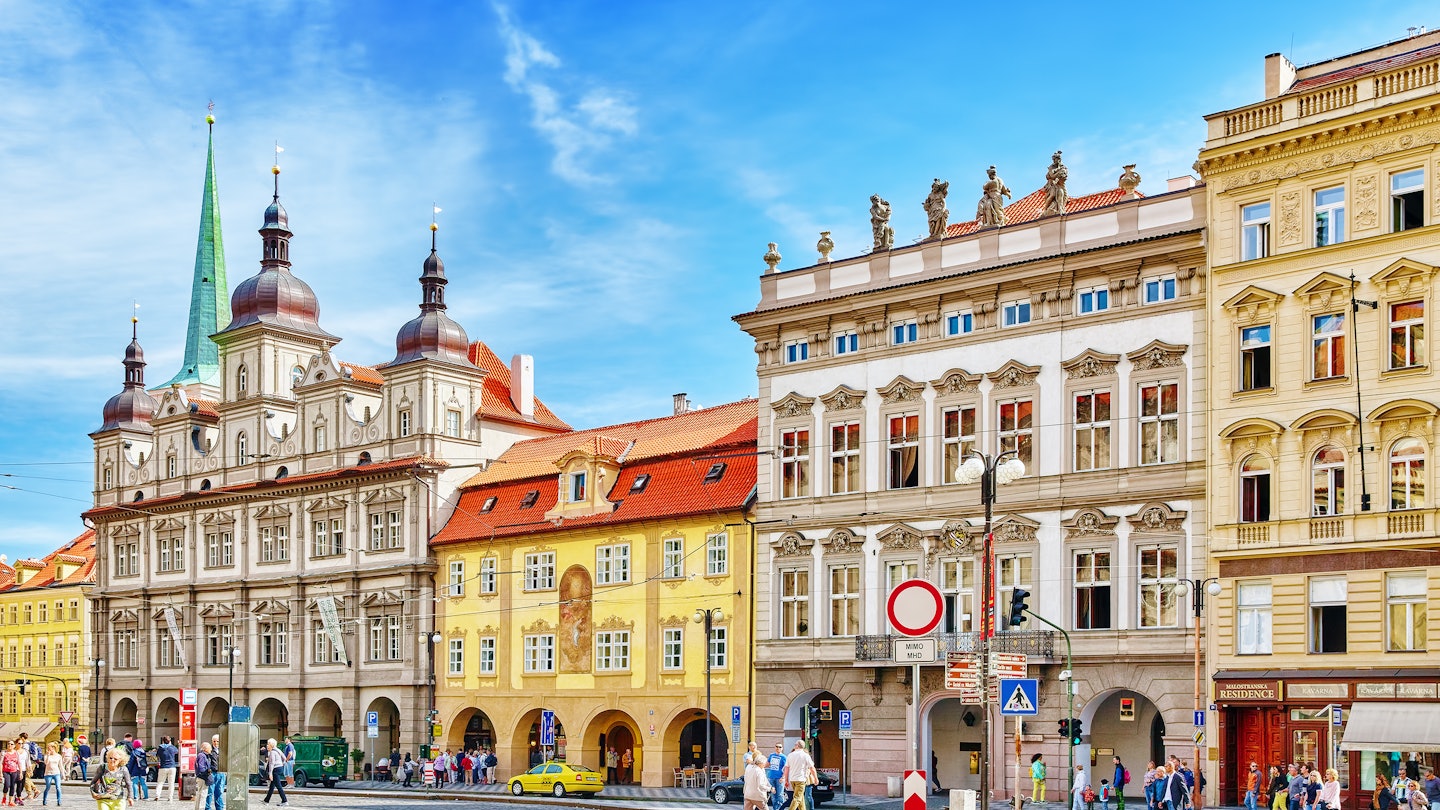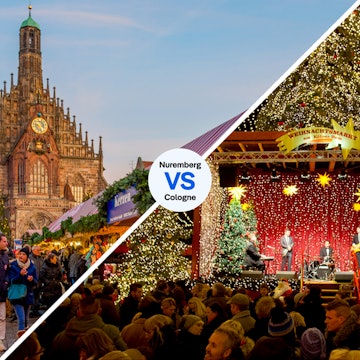

The main square of Prague's Malá Strana. V_E /Shutterstock
Prague is a city that knows how to surprise.
Wander its beautiful medieval core, and you’ll soon be bumping into both fairy tale vistas and provocative street art. At night, small, dimly lit doorways can lead to vast convivial beer halls, whereas riotous music clubs hide behind grand art deco facades. Whatever brings you to the eclectic Czech capital, though, it’s best not to be thrown completely off guard.
Come prepared with these insider tips and make the most of a trip to Prague.

1. You might not want to stay in Wenceslas Square
With its abundance of soaring spires and must-see attractions, Staré Město (Old Town) is a good-looking and convenient base – but don’t overlook Prague’s other neighborhoods. The center is compact, and the neighboring districts of Malá Strana and Nové Město are also handy for the sights and have their own gauntlet of pubs, bars and clubs. Just be aware that Wenceslas Square transforms from a respectable shopping destination into party central after dark, and its glut of strip joints can attract roaming stag parties.
For those keen to see where locals kick back or those traveling with children, head to the outlying districts. Both cosmopolitan Vinohrady and hip Holešovice have good-value stays, fun nightlife and top-notch transport links.
2. Pack comfy shoes and layers
Central Prague’s timeworn streets and alleyways are best explored on foot. Pack comfortable shoes that are cobblestone ready; high heels can lead to falls.
Besides dressing for upscale restaurants or a night at the theater, Czechs are a casual lot. Comfy layers – which can be peeled back in a subterranean pub and then restored during a blustery walk home – will help you blend in. Whatever the season, never discount the chance of a rain shower, so bring a raincoat too.

Meet your new travel partner
Unlimited data while you travel with Holafly eSIM. Use code LONELYPLANET for an exclusive discount.
3. The metro doesn't go all the way to the airport
Prague has an excellent affordable public transport system. Its main pitfall is that the metro doesn’t quite stretch to the airport. The cheapest route to Prague’s Old Town is to catch the often busy 119 bus to Nádraží Veleslavín station and then change to metro Line A. Tickets can be bought either in the visitor center or from machines in the terminals, which mostly accept contactless debit/credit card payments. If you’re staying close to Prague’s central train station, consider taking the slightly more expensive but direct Airport Express bus.
4. Pre-book your airport taxi for the best price
Opportunistic taxi drivers can be a problem. If you want to avoid hulking suitcases on and off buses, it’s best to arrange a transfer in advance rather than stepping into a cab outside the airport (or the main train station). At the very least, ask about the price before you set off, and let the driver know you’ll want a receipt. Uber, Bolt and local company Liftago are popular ride-hailing apps.

5. Validate your public transport ticket
Public transport tickets lasting from 30 minutes to three days can be bought at most newspaper stands, corner shops, and in all metro stations. Trams also have orange contactless debit/credit ticket machines onboard. Alternatively, you can use the PID Lítačka app. Just make sure to validate your ticket when starting your journey. This involves popping it into the yellow machine inside buses and trams or at the top of the metro escalators (or clicking the button on the app); forgetting can leave you with a hefty fine.
6. Prague is a good value, but not quite as cheap as it once was
Although prices have increased in recent years, Prague is still a good destination for budget-conscious travelers compared to many European capitals. The currency you’ll be spending is known as both Czech koruna and Czech crown. Beer remains refreshingly cheap, and a 500ml (16oz) mug will only set you back about 55Kč (US$2.60). A cappuccino is approximately 70Kč (US$3.30), and a decent traditional Czech meal costs around 200Kč ($9.50). It’s usual to tip around 10% for table service.
Buying the Prague City Pass or Prague CoolPass means free and discounted admission to some key attractions and sightseeing tours, although you’ll need to work hard to make either worth the investment. If you’re on a budget, paying for a few key attractions and making the most of Prague’s free diversions makes more sense.
7. Don't expect much small talk
If you come from a culture where having a chat about the weather is the obligatory warm-up to every interaction, you may find the Czech approach more abrupt. Czechs (like everyone) can be very warm and funny, but being reserved with strangers is common. Be polite, but it’s fine to get straight to the point.
8. English is widely spoken, but a little Czech is welcome
It’s common for people who live or work in Prague’s tourist hot spots to speak English. Menus and museum information boards will usually be translated into English, too. For the odd occasion where you’re struggling to be understood, it’s worth having the Google Translate app ready on your phone.
Despite the ubiquity of English in central Prague, some basic Czech is appreciated. Greet people by saying, "Dobrý den" (good day) or "Dobrý večer" (good evening). The more informal "Ahoj!" (hi/bye!) is best saved for close friends and relatives.
9. Try traditional Czech baked goods
Chimney-shaped cakes called trdelník are hawked at stalls by most tourist attractions, and they’re an Instagram favorite. The thing is: they aren’t Czech, but rather Slovakian or possibly Hungarian. So, sure, devour one of these sugar-encrusted towers (they’re delicious), but it’s also worth scouring local bakeries for some more traditional Czech treats. Keep a hungry eye out for kolaches – palm-sized, sweet-bread disks filled with poppy seeds or fruit jam.
10. Be wary of exchange rates that look too good to be true
Some unscrupulous currency exchanges promise brilliant deals and then charge hidden fees. When changing money, ask for the final amount in writing before handing over your cash, and make sure you get a receipt. If you believe you’ve been given a bad deal and have changed less than about €1,000 (US$1700), you have three hours to cancel the transaction. A more scam-proof alternative is to have a bank account that offers reasonable rates and low fees for international withdrawals and use an ATM.

11. There are ways to sidestep the crowds
Prague can get hectic, especially in the late spring and summer. To escape the hubbub, venture beyond the tourist triad of Charles Bridge, Old Town Square and Prague Castle. For example, instead of jostling through selfie sticks, admire Charles Bridge from the river islands of Kampa or Střelecký ostrov. Also, consider swapping the carnival atmosphere of Golden Lane for a romantic stroll around the tranquil castle district of Nový Svět. And if it all gets too much, find a shady spot in one of Prague’s handsome parks (some come with beer gardens and sweeping city views) – or consider a day trip from the city.
12. Take standard safety precautions and use common sense
Prague is generally a safe city: violent crime rates are low, traffic rules are followed, and the tap water is clean. Take the same precautions you would in your home country and be especially vigilant about your belongings: pickpockets have been known to target crowded tourist areas, trains and trams. Should you need emergency help, calling 112 guarantees an English-speaking operator.
13. Get travel insurance
The Czech Republic has high-quality health care. If you need a Schengen visa for entry, having medical insurance is mandatory. Visitors from the EU can get free emergency treatment in Prague by showing their European Health Insurance Card (EHIC) or, for travelers from the UK, the Global Health Insurance Card (GHIC). It’s still advisable to take out travel insurance, as the cards do not cover all costs, such as medical repatriation.














